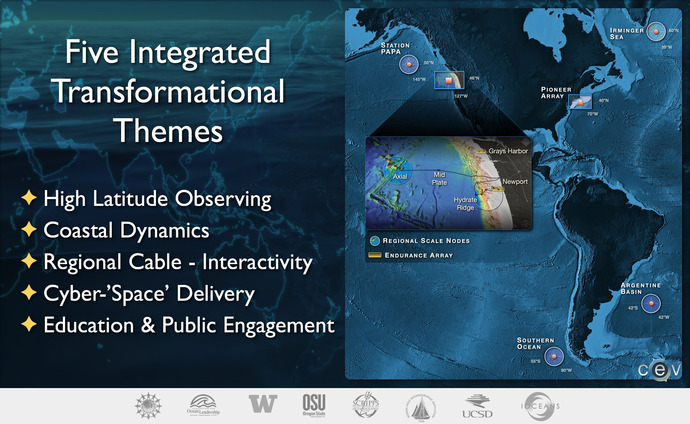NSF Ocean Observatories Initiative

Regional, Coastal, Global Studies: Spanning the Western Hemisphere
The National Science Foundation's Ocean Observatories Initiative (NSF-OOI) will construct a network of instruments, undersea cables, and instrumented moorings that spans the Western Hemisphere. The OOI will be one fully integrated system and will measure physical, chemical, geological, and biological phenomena in carefully selected key coastal, regional, and global areas.
Greater knowledge of the ocean’s interrelated systems is vital for increased understanding of effects on biodiversity, global warming, ocean and coastal ecosystems, environmental health and climate. The OOI will put real-time ocean data in the hands of a vast user community of oceanographers, scientists and researchers, educators and the public.
The OOI Program is managed and coordinated by the OOI Project Office at the Consortium for Ocean Leadership, in Washington, D.C., which is also responsible for construction and initial operations of the OOI network. Three major Implementing Organizations are responsible for construction and development of the overall program. Woods Hole Oceanographic Institution and its partners, Oregon State University and Scripps Institution of Oceanography are responsible for the coastal and global moorings and their autonomous vehicles. The University of Washington is responsible for cabled seafloor systems and moorings. The University of California, San Diego, is implementing the cyberinfrastructure component. The fourth implementing organization, led by Rutgers University in partnership with the University of Maine and Raytheon Mission Operations and Services, is responsible for the education and public engagement software infrastructure.
Regional: Cabled high power and bandwidth
The cabled high power (up to 200 kW) and bandwidth (up to 240 Gb/s) component of the NSF OOI is called the Regional Scale Nodes (RSN). This network spans the Juan de Fuca tectonic plate, and includes cabled arrays of sensors on the seafloor and throughout the water column. Implementation of the OOI Regional Scale Nodes is led by the University of Washington. Shallow-water, cabled coastal sites off the Oregon coast are shared by the University of Washington and Oregon State University; the UW manages the cable technology.
Coastal: Cabled and uncabled moorings
Coastal studies in the Pacific will be facilitated by an array of cabled and uncabled moorings across the continental shelf off Newport, Oregon, and Grays Harbor, Washington. Implementation of the Coastal Scale Nodes is overseen by Woods Hole Oceanographic Institution and its partner, Oregon State University.
Global: Moorings at high latitudes
Global studies will be facilitated by moorings at four sites, one each in the Pacific near the Queen Charlotte Islands, the Southern Ocean near Chile, the Atlantic near Greenland, and the Atlantic off Argentina. Implementation of the Global Scale Nodes is overseen by Woods Hole Oceanographic Institution and Scripps Institution of Oceanography.
Unprecedented opportunities: streaming via the Internet
High-bandwidth data, high-definition video and digital still imagery will be streamed live from the cabled observatory via the Internet to researchers, educators, and the public. Data from uncabled moorings will be sent to satellites and then to the internet. The Cyberinfrastructure component of the OOI will facilitate use, storage, and visualization of the myriad data sets. Implementation of the cyberinfrastructure architecture is led by the University of California, San Diego.
In concert this transformative infrastructure with real-time and adaptive capabilities will provide unprecedented opportunities for scientists, educators, and the public to participate in cutting-edge oceanography. The Education and Public Engagement component of the OOI will help facilitate use of this infrastructure by a diverse national and international community.




